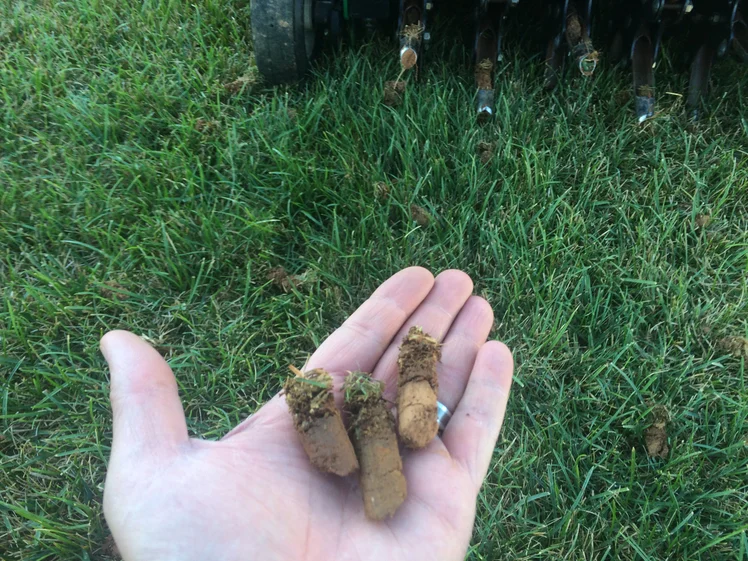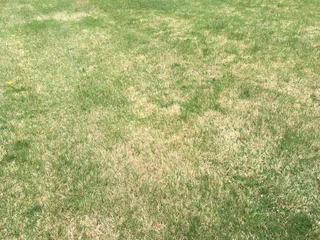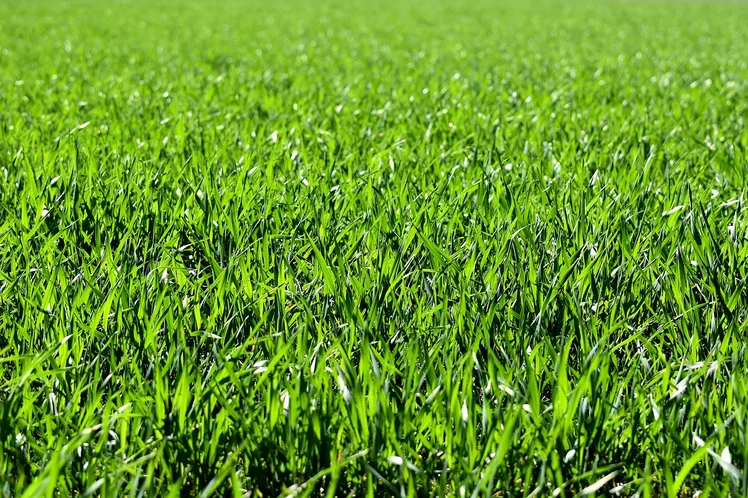Lawn lingo can get confusing.
Hydroseeding. Slice seeding. Aeration and overseeding.
All you know is, you need a better lawn.
But how to get it?
Paul Brooks has you covered. He’s the owner/operator of Weed Man, Greenscape, Inc.’s lawn care division.
Hydroseeding vs slice seeding vs aeration and overseeding — what’s your best bet?
Take a break from staring sadly at your lawn and read on.
Aeration And Overseeding Wins
Brooks has a way of cutting right to the chase. Chances are, he says, if you live here in North Carolina, you want aeration and overseeding.

Sure, there are a couple exceptions, and we’ll get to those in a minute.
But really, aeration and overseeding should set you and your lawn up just great.
Here’s why:
Just Assume Your Soil Is Compacted
Aeration is a key part of the equation here in North Carolina, where most of the soil is clay.
Clay soil has its good points, Brooks says. It holds moisture and nutrients much better than sandy soil.
But it compacts like crazy.
So before any seed goes down, your clay soil needs aeration.
Aeration uses a machine to pull out tiny cores of soil from your lawn. These new holes allow water and oxygen to get to the roots, so they can grow nice and deep.
Aeration is followed by overseeding. All those fresh new holes provide the perfect spots for grass seed to settle and germinate.
“We seed before and after we aerate,” Brooks says. “That puts the seed at different levels in the soil, which provides great soil to seed contact — and that’s what you want for good germination.”
The Trouble With Slice Seeding
Slice seeding won’t do a thing if it’s done in compacted soil, Brooks says. The slice seeder has a row of blades that slice down into the soil, creating openings for the seeds.
But even the slicer’s sharp blades can’t battle compacted clay soil, he says.
“Unless you have a brand new site with fresh, new soil, you really need aeration,” Brooks says.
In fact, the compacted clay soil around here is such an issue, Brooks doesn’t even do slice seeding. It’s not worth it, he says, to drop seeds in the ground without breaking up the stubborn clay soil first.
When Hydroseeding Works Best
Hydroseed is a mixture of grass seed, water, and fertilizer that’s sprayed onto your yard or property with a hose.
It has to be applied to bare soil, so it’s a good choice for new construction, because the ground is already fresh and bare.
Hydroseeding has its place, Brooks says.
“It’s good for large areas or slopes where you can’t use machines,” he says. “You can also mix in organic matter. When you spray the seed, it’s mixed with water and organic matter, and that’s good for the soil.”
Here at Weed Man, we don’t do hydroseeding. Brooks just doesn’t see enough demand for it.
“The average homeowner is not going to get hydroseed unless it’s a brand new lawn,” he says. “It’s a pretty big production.”
If you have any grass at all on your property, it has to be removed before the hydroseeding takes place, so only bare dirt remains.
Tempted To Green Things Up? Don’t

Some homeowners like to overseed their lawn with rye grass to help green it up over the winter.
“I don’t really recommend that,” Brooks says. “That’s just another grass in the mix to compete for nutrients and water in the spring. If you have a warm season lawn, just let it go brown.”
A Word About Water
Grass seed needs water to germinate. If there’s no rain in the forecast after you seed, don’t panic, Brooks says.
“The seed will sit there until it gets moisture,” he says. “But if you decide to water, you have to keep watering. Once you start to water, the seed will germinate. Then, if you stop watering, it will dry up and die. It’s best to let it sit and let Mother Nature take care of it.”
What’s Best For You? Have Brooks Take a Look
Now you know aeration and overseeding is the right method for Triangle Area lawns, but what type of grass is right for your property?
Here in North Carolina, we’re in the transition zone, Brooks says, which makes it tricky for any kind of grass to flourish.
“West and north of the Triangle Area, there’s more fescue, a cool season grass,” he says. “South and east you see more warm season grasses, like Bermudagrass.”
Cool season grasses like tall fescue are planted in September and October here, Brooks, says — not the spring. Grass planted in the spring doesn’t have a chance to establish a good root system before the heat of summer.
“What I recommend depends on the site,” Brooks says. “Is there enough sun to support warm season grasses? Do you have common varieties in your lawn already that we can promote?”
He’s happy to take a look.

Trust Your Lawn To Greenscape
Lawns are complicated, especially around here.
Hydroseeding vs slice seeding vs aeration and overseeding? Lucky for you, we have experts like Brooks onboard who can cut through the confusion and help you make sense of it all.
We’ve been meeting the full-service landscaping needs of commercial and residential customers in the Raleigh, Durham, Chapel Hill and Cary areas for more than 35 years.
We offer landscape management and lawn care, design and build services, irrigation, landscape lighting and more.
Call us at 919-552-7742 or fill out our online form to request a free consultation and learn how we can transform your landscape.
We can’t wait to hear from you.
